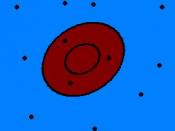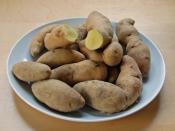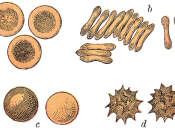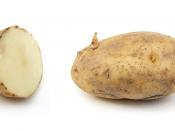"Do different concentrations of solutions determine the mass of a potato?"
Introduction:
The way to get the full results of this lab was through the process of osmosis. Osmosis is the movement of water across a membrane into a more concentrated solution to reach an equilibrium. When regarding cells osmosis has three different terms that are used to describe their concentration. The first of these words is isotonic. Cells in an isotonic solution show that the water has no net movement and the amount of water that goes in is the same that goes out. Isotonic comes from the root iso, which means equal. This makes sense because the definition of isotonic is: same concentration. The second out of three words is hypotonic. Cells in a hypotonic solution make the water move into the cell to spread out the cells solutes to eventually reach an equillibrium. Hypotonic comes from the root word hypo, which means low/below.
The actual definition for hypotonic is: less concentrated. Hypertonic is the last out of the three words. A cell in a hypertonic solution makes the water leave the cell to try to spread out the solutes outside to eventually reach an equillibrium. Hypertonic comes from the root word hyper, which means more/high. The definition of hypertonic is: more concentrated.
A plant cell in two out of three of these conditions can be crucial to a plants health. In an isotonic solution, a plant cell has no net movement of water. A word for what occurs is flaccid. When solution is isotonic the vacuole is not full and that is really bad because a plant needs its nutrients and a full vacuole makes it stand tall (turgar pressure). In a hypertonic solution, the vacuoles lose water; the cytoplasm shrinks and chloroplast are seen in the center of the cell. A word that describes this is plasmolysis. This is bad for a plant cell because the retraction of the cell membrane causes it to rupture/tear.
In this experiment we tested potatoes and put them through some solutions that have different concentrations to see what would happen. Would it shrink or would it swell? Those were the two main questions that were asked in this lab.
Hypothesis:
Based on prior knowledge I made an educated guess on the outcome of the results. For my hypothesis I said that for the molarity level of 0 and .2 the potato core was going to swell, making the condition the cores were in hypotonic. When the molarity turned into .4 I said that the core would stay the same and therefore be isotonic. When the core was placed in the .6, .8, and 1 molarity solutions I thought that the cores were going to shrivel making the conditions hypertonic. The reasoning behind these assumptions is based on the definition of molarity. Molarity is the measure how concentrated something is. The reasoning why I think its starts to swell at first but then shrink is because the less concentrated a solution is causes it to have more water to be available in its surroundings. So the more concentrated the solution is will cause there to be less water in their surrounding so there wont be as much to take in so it will shrink. At .4 molarity I thought the surroundings would be isotonic just because it was just about in the middle and there wasn't too much or too little concentration.
Methods:
Once the right materials were gathered for the experiment process the set-up process was initiated. First the 5 test tubes were labeled with their corresponding concentrations of solution. The concentrations consisted of 0m, .2m, .4m, .6m, .8m, and 1m. The 6 cut up pieces of potato were weighed separately on a scale to collect their mass. The potato pieces were all placed into the test tube they were assigned after collecting the data so there would be no mix-ups. A pipette pump is used to carefully squirt the concentrated solutions into their designated test tubes. The solution was squirted until it covered the potato completely. This was repeated with every solution into their own-labeled flasks. After that process was finished a piece of parafilm was placed on each of the test tubes and securely fastened. The dependent variable in the experiment was the percent change in mass and the independent variable was the solution. This is a quantitative experiment because it was measuring the percent change in the mass of the potatoes.
Results:
Data:
The chart below shows the % change in mass after being in their concentrated solutions:
Next Page (didn't fit)
Concentration (M)0m.2m.4m.6m.8m1m
Initial Mass(g)3.6g3.8g3.9g3.1g3.0g3.0g
Final Mass (g)4.1g3.9g3.4g2.2g2.0g1.9g
% Change in Mass14.9%1.8%-12.1%-28.6%-33.3%-36.9%
Analysis:
The Graphs below show the percent changes in mass for both the class averages and our group's averages:
Conclusion:
In conclusion when the molarity level was at 0 and at .2 the potatoes had gained mass so therefore they were placed in a hypotonic environments. When the molarity level was .4 and above the potatoes loss mass so therefore they were placed in hypertonic environments. So the different in concentrations does change the mass of the potatoes because they determine the osmosis environments.
Discussion:
The hypothesis for this experiment was that at 0m and at .2m the potato core was going to swell making the surroundings it was in hypotonic. For .4m it was stated that the potato core would stay the same, making the surroundings it was in isotonic. For that last three solutions, .6m, .8m, and 1m, it was thought that they would shrink, so that would mean that that the environment that they were placed in was hypertonic. Although these results made sense only the real results can give the right answer. After collecting the data it was revealed that the assumptions made for the 0m and .2m solutions were correct. The data had showed that to 0m solution had a 14.9% change in mass and the .2m solution had a 1.8% change in mass. These percentages showed that the potatoes had gained mass. For the .4m solution, the hypothesis made was incorrect. The data showed that there was a -12.1% change in mass. This proved that in this solution the potato core had lost mass and it was assumed that the mass would stay the same. For the .6m, .8m, and 1m solutions the hypothesis was proven correct. The results showed that for the .6m solution there was a -28.6% change in mass, for the .8m solution there was a -33.3% change in mass, and for the 1m solution there was a -36.9% change in mass. This all proved that the potatoes had lost mass in these solutions.
Some areas of error were mostly during the process of weighing the potatoes and putting the right solution into their designated test tubes. For example there was some point in which it was uncertain if one of the solutions was already put into a test tube or not. If the solution was put into two different test tubes that could have lead to a false positive or false negative result depending on what the molarity level of the solution was. Also in the weighing process of the final mass the potatoes were taken out of the test tubes were they were soaked in the solution. The access solution left on the potato can be transferred to the scale and give the mass a more positive result making it a false positive. This could have been avoided by wiping off the access water of the scale.
Even though the potato pieces were cut into cubes as best as humanly possible the potato pieces did end up being different sizes. Although this seemed like a set back it wasn't because the change in the potato cores was measured by the difference in mass by measuring the potato before and after. Surface area won't affect osmosis, only if the item used was thicker it could prevent more water from getting in, but otherwise surface area can only speed up or down osmosis.
If modifications could be made to this experiment there are some things that were considered. For example the potato pieces could have been cut with more patience so that they were as equal to each other as possible. Also the whole experiment could be doubled by having twice as many potatoes to put in 2 test tubes of each solution. This would ensure that the results had fewer mistakes. Also there can be other variations of this experiment by having other start items that aren't necessarily potatoes. These modifications can make a big difference in the study of osmosis.





